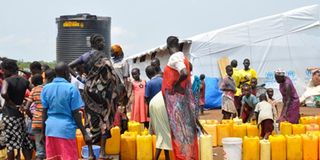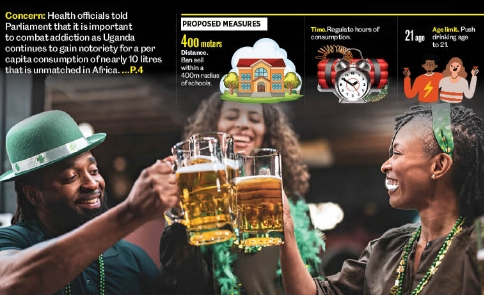Refugee influx takes toll on Adjumani

Refugees collect water at Pagirinya Refugee Settlement camp in Adjumani District. PHOTO BY EDGAR R. BATTE
What you need to know:
As of beginning of August the refugee population had hit 170,000. More than 85 per cent of the refugees currently arriving in Uganda are women and children under the age of 18 who lack access to proper shelter, food and health facilities, among other basic necessities.
The long dusty, winding road at Elegu border between Uganda and South Sudan, is a busy stretch.
From a distance, a mother appears with a baby strapped on her back, her hands readily available to aid her carry firewood, mattresses, hoes and other belongings. These will be useful in her ‘new home’.
As she advances, with tired steps, she guides her other three children away from speeding cars and motorcycles.
Soon, one of her younger children starts crying out loud. The woman stops for a minute, goes on her knees and settles the load from her head onto the ground, in order to comfort the crying child. Her cries reduce to sobs as she falls into her mother’s chest.
The embrace lasts about three minutes, the woman’s eyes tearing effortlessly, wet lines running down her dusty face. In a split second her baby goes silent as she looks on at her siblings who seem puzzled altogether. They seem hardened to the situation.
The family is one of many refugees grappling with life. It is fleeing from the effects of war in South Sudan where South Sudan’s President Salva Kiir and his former deputy Riek Machar are pitted against each other in yet another resurgence of power struggle characterised by violence that is adversely affecting locals of the world’s youngest nation.
According to United Nations High Commissioner for Refugees (UNHCR), UN’s refugee agency, more than 85 per cent of the refugees currently arriving in Uganda are women and children under the age of 18.
Life anew
The families are heading to Pagirinya Refugee Settlement in Adjumani where they will start life all over again; find space to put up shelter with some sticks, perhaps not. Many refugees sit in groups, others lying on the ground, resting their heads on stones or tree branches, under the scotching sun. Most trees have been cut down.
One mother, who spent the night just outside a make-shift clinic, is trying to nap but her month-old baby cannot let her sleep.
“Many children have lost one or both of their parents. Most are from Eastern Equatoria State, with smaller numbers from the capital, Juba, and Upper Nile State. Many took advantage of the opportunity to flee alongside Ugandan military convoys evacuating Ugandan nationals,” says UNHCR spokesperson Melissa Fleming.
Michael Laku Severino came with one of the army trucks evacuating Ugandans from Nimule in July. He brought along with him his two daughters.
The theatre attendant says he was attending to a patient when soldiers attacked Nimule Hospital..
“My wife and son had gone to the market to get food,” he says of the fateful day.
He has neither seen his wife again nor their son. For now, he has to keep comforting his daughters, who want to return to school, or when their mother will be ‘coming’ to join them.
“Children are the most vulnerable group during emergencies and in the aftermath of a disaster, they are faced with long-term impact of trauma both emotionally and physically. It is the responsibility of everyone to ensure their safety and protection,” Rashid Javed, country director of Plan International Uganda, a humanitarian organisation, said.
UNHCR estimates that more than 2.6 million of South Sudan’s citizens have been forcibly displaced, making the state among the countries ranked with the highest levels of conflict-induced population displacement globally. Half of its people rely on humanitarian aid.
Titus Jogo who mans the Refugee Desk Officer (RDO) in charge of Adjumani under the OPM states that as of beginning of August the refugee population had hit 170, 000 individuals.
This has put pressure on land in the district as bush thickets and trees are cleared to create settlement space for the refugees in the area. One of settlements is Pagirinya where more land has been cleared.
Refugees can be seen cutting trees, others carrying tree stems and branches to mini-construction sites, to put up temporary shelters from the scotching sun, rains and the chill of the night.
“If the population of refugees in Adjumani outnumber the population of the host community, the pressure on the environment will be high. Refugees destroy the environment,” Jogo observes.
Much of the space in Pagirinya is occupied. Adjumani cannot accommodate much more, so land has been identified.
Jogo explains that they have transported some refugees to Yumbe District. However, the transfer of refugees to neighbouring Yumbe sparked off mixed reaction with some migrants demonstrating, citing late communication and preference to stay in Adjumani where they felt ‘at home’ since they could easily communicating in Ma’di, a language spoken by locals too.
Spill over effect
“We had some challenges with those (refugees) in Nyumanzi. We had not sensitised them on where we were going to take them. The lists were displayed a bit late,” Jogo added. Only 359 out of 15,000 refugees were willing to be transported to Yumbe.
South Sudan became the world’s newest nation and Africa’s 55th country on July 9, 2011, following a peaceful secession from the Sudan through a referendum in January 2011.
“Unfortunately, the nearly two-year long conflict, which broke out in Juba on December 15, 2013 and later engulfed three of the 10 states of the country, deteriorated development gains achieved since independence and worsened the humanitarian situation,” a World Bank Economic Overview states, in part.
The spill over effect of the war might reverse the economic gains. Some 30 relief agencies work out of refugee camps. Plan International is one of them. It recently donated non-food items worth Shs550m in refugee camps, but this did not sufficiently settle needs of the refugee population.
Many left grumbling, sad and blue that their names had not been read out to allow them chance to get the relief items that included soap, tents, mosquito nets, jerry cans, blankets and saucepans.
But their deeper qualms were about the food rationing in the wake of the July resurgence that saw new refugees cross to Uganda.
Ben Paska Opia, who has lived in Adjumani for the last three years, and a refugee from Eastern Equatoria State, explains that the OPM is shifting attention away from ‘old’ refugees to fresh ones and has subsequently cut down on the food supply they given them (the old refugees).
“Whenever new refugees arrive, it affects us. They cut our food ratio from 50 per cent to 25 per cent. We call upon government to join hands with other organisations to help new refugees so that our food is not rationed,” Opia pleads.
But it is more than quantities of food rationed. Many children have protruded tummies, which Jogo acknowledges as a sign of malnutrition. There are many countable young souls with brown hair with a shade of yellow, which further proves poor feeding.
Ms Fleming says both Kenya and Uganda are reporting rising cases of severe malnutrition, particularly among very young children.
“Those found to be suffering are being placed on food nourishment programmes to bring them back to health,” Fleming said. However, with the increasing numbers, adequate feeding is fast-becoming a challenge in the refugee settlements across the region.
Since conflict erupted in December 2013, it has produced one of the world’s worst displacement situations, along with immense suffering.
Factfile
The resumption of war in July this year has seen some 3,000 refugees cross to Uganda, on a daily basis, through the Nyumanzi reception centre in Adjumani. Figures provided by the Office of the Prime Minister (OPM) in Adjumani District, in northern Uganda, indicate that the refugee influx threatens to outnumber the population of locals in the area.
2014 National Census figures indicate that Adjumani had a population of 210, 000.




